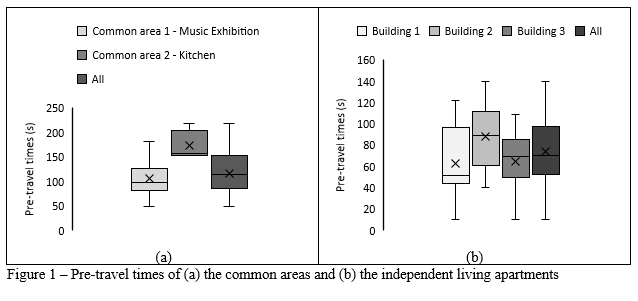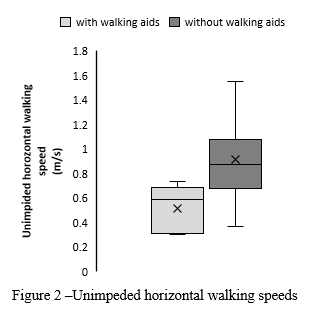Evacuation Data from Retirement Facilities in New Zealand
Ruggiero Lovreglio, School of Built Environment, Massey University, Auckland, New Zealand
Anass Rahouti, Fire Safety Consulting sprl, Belgium
Daniel Nilsson, Civil and Natural Resources Engineering, University of Canterbury, New Zealand
Erica Kuligowski, School of Engineering, RMIT University, Melbourne, Australia
Phil Jackson, EvacuationNow Ltd, New Zealand
Aging populations are generating new challenges for buildings and infrastructure designers around the world. Elderly populations are more likely to have mobility impairments and require a longer time to respond and evacuate during a fire than able-bodied adults. As such, it is fundamental requirement to account for the differences in evacuation performance of aging populations when designing retirement facilities. To date, only a few studies have been carried out to measure the evacuation performance of elderly evacuees during the pre-travel and travel phases [1,2]. This work provides an overview of new data obtained by analyzing unannounced and announced day time evacuation drills carried out in several retirement facilities in Auckland, New Zealand, in 2018-2019[3]. The data was collected through the observation of the behaviors of 118 elderly evacuees and 16 staff members. A summary of the pre-travel time distributions, speed distribution, and fundamental diagrams for elderly evacuees are reported in the following sections.
Fire Drills
Data were collected from 16 drills carried out in independent living apartments and common areas belonging to different retirement facilities. All of the drills were unannounced, with the exception of one. None of the drills prompted a full evacuation of the entire building. Rather, the goal of the drills was to evacuate single fire compartments by evacuating horizontally from one fire compartment to its adjacent fire compartments. The unannounced drills were started by activating one of the smoke detectors in the fire compartment. This started a local fire alarm, which required one staff member to identify the origin of the fire and to activate the alarm in the entire compartment. In the announced drill, the fire compartment alarm was activated by the evacuation consultant running the drill after informing the participants a walkthrough drill would take place.
Pre-Travel Phase
Pre-travel times were collected in all of the unannounced drills focusing on independent living apartments and common areas of the retirement facilities. The pre-travel time of an evacuee is defined as the time between the activation of the alarm in fire compartments and the time when the evacuee started to move towards a place of safety. Figure 1 shows the pre-travel times observed in independent living apartments and common areas. These data were used to estimate pre-travel time distributions, which are published in [3].

Travel Phase
Unimpeded horizontal walking speeds were collected in different drills wherever the density of the evacuees was smaller than 0.54 persons/m². These speeds were divided into two classes depending on whether the evacuees were using walking aids. Figure 2 illustrates the speed data for these two groups. The boxplots clearly illustrate that evacuees in retirement facilities move at different speeds depending on their need for walking aids. Evacuees who used walking aids moved at an average speed of 0.51±0.19 m/s, while evacuees who did not use walking aids moved at an average speed of 0.91±0.29 m/s. This difference was proven to be statistically significant.

Figure 2 –Unimpeded horizontal walking speeds
The announced drill also allowed the investigation of the relationship between density and horizontal speed. The local density and speed were measured in a section of a corridor using the assumptions described in Section 3.2 of [3]. This data is shown in Figure 3 and is compared with the SFPE fundamental diagrams published in [4]. The figure shows that the walking speeds ranged from 0.13 to 1.55 m/s, the local density ranged from 0.00 to 0.83 persons/m², and the specific flow ranged from 0.00 to 0.33 persons/s/m of effective width. The figure also shows that most experimental data points fell below the SFPE relationships. This indicates that the use of SFPE fundamental diagrams in the modelling of retirement home evacuations may lead to overly optimistic results, and it can severely underestimate the required evacuation time.

Conclusion
This work summarizes the main findings obtained from 16 evacuation drills carried out in three retirement facilities in New Zealand. The drills involved 61 staff members and 118 residents. Results indicate that pre-travel time ranged from 48s to 219s in communal areas and from 10s to 140s in areas with independent living apartments. While the pre-travel times from the independent living apartments are in line with the one study existing in the literature, the times from common areas are lower than those reported in the literature. This work presents new unimpeded horizontal walking speeds for residents of retirement facilities. These speeds range from 0.3m/s to 0.73m/s when using walking aids and from 0.37m/s to 1.55m/s when not using walking aids. Finally, comparison of the proposed data and the SFPE fundamental diagrams highlights that most of the experimental data points in the current study fall below the SFPE design curve.
Note: This paper is a short version of a manuscript that has been published in the Fire Technology journal. Further information about the evacuation drills and collected data can be found in the full article associated with this work [3].
References
[1] R. Lovreglio, E. Kuligowski, S. Gwynne, K. Boyce, A pre-evacuation database for use in egress simulations, Fire Saf. J. 105 (2019) 107–128. https://doi.org/10.1016/J.FIRESAF.2018.12.009.
[2] S.M. V. Gwynne, K.E. Boyce, Engineering Data, in: SFPE Handb. Fire Prot. Eng., Springer New York, New York, NY, 2016: pp. 2429–2551. https://doi.org/10.1007/978-1-4939-2565-0_64.
[3] A. Rahouti, R. Lovreglio, D. Nilsson, E. Kuligowski, P. Jackson, F. Rothas, Investigating Evacuation Behaviour in Retirement Facilities: Case Studies from New Zealand, Fire Technol. (2020). https://doi.org/https://doi.org/10.1007/s10694-020-01058-x.
[4] S.M. V. Gwynne, E.R. Rosenbaum, Employing the Hydraulic Model in Assessing Emergency Movement, in: SFPE Handb. Fire Prot. Eng., Springer, 2016: pp. 2115–2151.